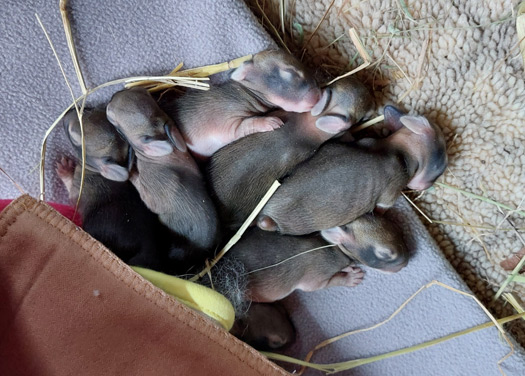

Homeowners frequently find bunny nests right in their own backyard. The bunny nest is a scraping (small depression) in the ground and generally located in tall grass or brushy areas. Sometimes the nest is found right in the middle of the yard. The mother rabbit lines the nest with dry grasses and fur pulled from her own abdomen for warmth and waterproof protection of the young. The bunnies are placed in the nest and lightly covered with the same dry grass/fur materials. The mother rabbit does not remain with the bunny nest. The eyes closed bunnies have no smell and will not be detected by predators unless they spot the mother rabbit on the nest. The mother rabbit only visits the nest to feed her babies and groom them about twice a day, usually at pre-dawn and dusk. She is "quick as a bunny" and remains at the nest for only a few minutes. People almost never observe a mother rabbit feeding her babies in the nest. The bunnies remain in the nest for about three weeks before venturing out to explore. This occurs when they are about five inches in diameter (about the size of a tennis ball). At this age, the bunnies are independent of their mother and will disperse from the area within a short time.
Please be aware that the juvenile bunnies have a tendency to "freeze" when approached by humans. Do not attempt to pick them up even though they appear tame. During this time, it is easy for dogs and cats to attack the young rabbits so please keep your pets under control.
If you find a bunny nest in your yard, do not assume the bunnies are orphans. In most cases, the mother rabbit is hiding in the grasses nearby. Review the following questions to help determine whether the baby rabbits need assistance:
- The bunnies appear thin, weak, and lethargic. Their bellies are sunken, especially if checked immediately after sunrise.
- There is a dead rabbit nearby (i.e. hit by car). Remember this is not a definitive sign that the bunnies need help. Only the mother rabbit cares for the babies and the dead rabbit might be a male.
- There are dead babies in the nest and the other babies appear weak.
There are several ways to determine whether baby bunnies are being fed by their mother. The only definitive way is to check the belly of one bunny shortly after dawn. If the mother rabbit has just fed the baby, you will see a full, rounded belly. Many times you can see the "milk line" through the thin skin over the belly. Be sure to wear gloves before performing this check. If you get your odor on the bunny, you risk the nest being found by predators. After checking, place the bunny back in the nest and cover them lightly with the nesting material.
Another way (less effective) to determine the presence of the mother is to use dental floss or string to make a "tic-tac-toe" pattern on top of the nest. If the pattern appears disturbed after 24 hours, the mother probably fed her babies. Please be aware that some mother rabbits have been known to feed their babies without disturbing the tic-tac-toe pattern. Therefore, the additional "belly check" is usually required before a final determination can be made.
Once you know that the mother rabbit is feeding her babies, please do not continue to disturb the nest with additional checks. Each time you touch the nest, you risk making the nest vulnerable to predators or making the mother rabbit feel unsafe to visit it.
Baby bunnies are one of the most difficult animals for wildlife rehabilitators because they die from stress-related diseases very easily. The mother rabbit is the best option for the survival of the babies. If you need ideas on how to co-exist with the bunny nest in your yard, please contact Cummington Wildlife, Inc. for advice.
